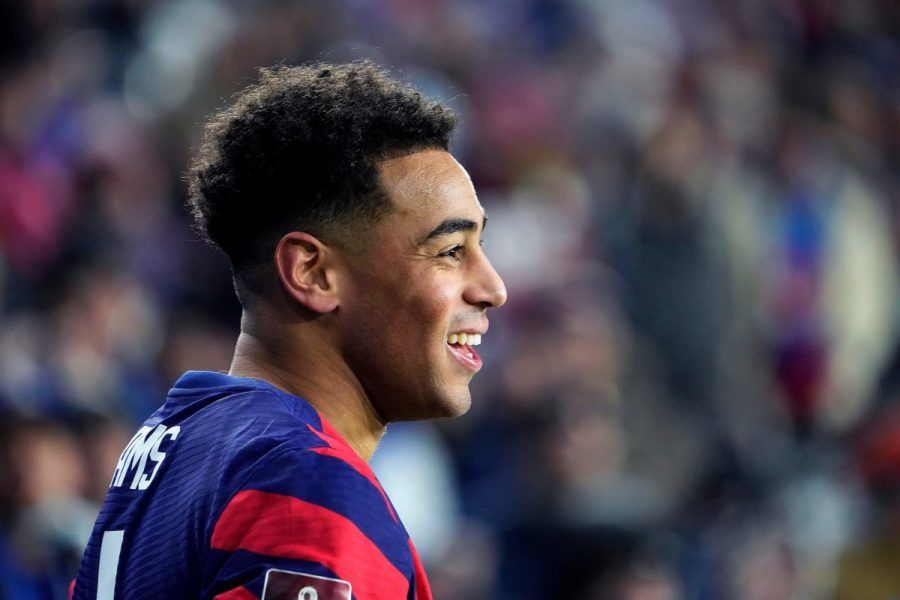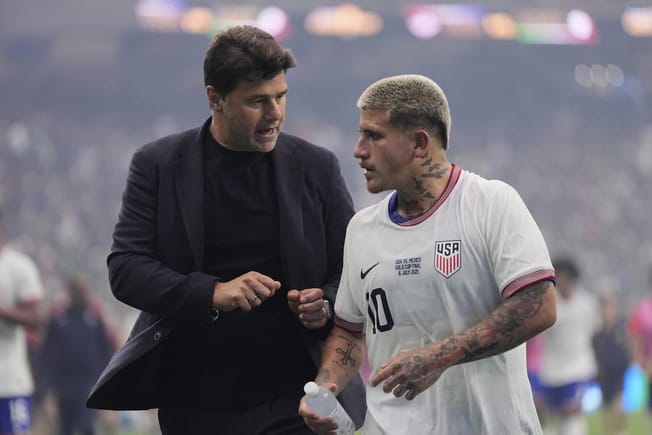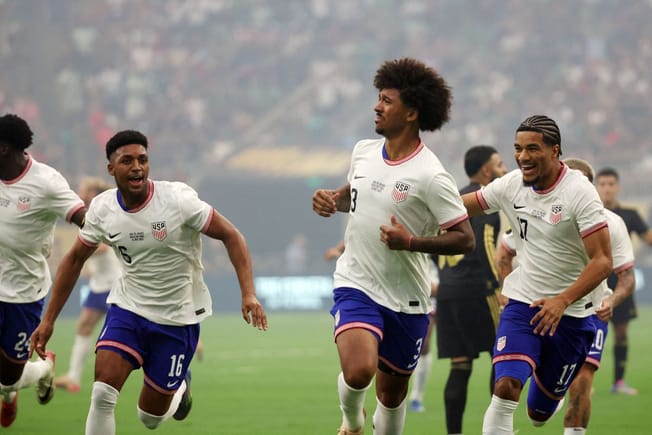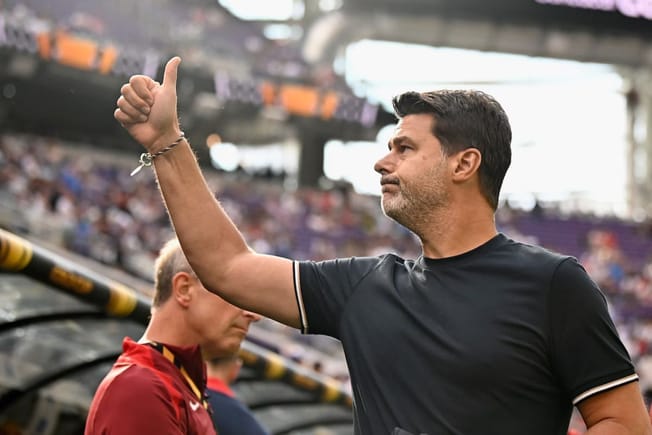For most of the top European leagues and clubs, the soccer season is over. In the last week, the dust has settled on various title-deciders and relegation battles, which means that silly season has begun.
It’s transfer time, people.
Most of the transfer windows for the big-spending European leagues don’t open until July 1st, but that’s never stopped the transfer rumor mill before. Rumblings related to all sorts of players, including some of the U.S. men’s national team’s stars, are alive and well.
Christian Pulisic may end up leaving Chelsea this summer. Tyler Adams could make a move away from RB Leipzig. Sergino Dest’s Barcelona future is reportedly in doubt.
I see that smile creeping across your face. It’s fun to play matchmaker for some of these American players and clubs. Dest could go to Bayern! Pulisic could join Weston McKennie in Serie A! Arsenal wouldn’t be so bad for Adams, right? Right?
Be honest. You love this stuff.
With less than six months until the U.S.’s first game at the World Cup, though, maybe it’s time for us all to step away from the mirror where we’ve been practicing our Fabrizio Romano impression for the last few hours.
This summer may not be the right time for Pulisic, Adams, and company to move.
Here’s why.
PLAYING TIME ISN’T THE GOAL
“Important. 100% important.”
That’s Adams’ response to a question about the value of getting regular and extensive playing time, which didn’t happen with Leipzig during the second half of the season.
He’s right, of course. Getting regular minutes is extremely useful for younger players while they try to get better at their jobs. The issue for Adams, though, is that he can’t stay healthy when he’s getting those precious minutes.
Adams missed the vast majority of the 2019-20 season with various injuries and picked up a number of injuries over the last two seasons as well. The 23-year-old has yet to hit the 2,000 league minutes mark in his three seasons with Leipzig, partially because of managerial decisions that pushed him further down the depth chart, but certainly because of his inability to stay healthy.
Pulisic hasn’t had any better luck with injuries: he missed a chunk of this year with an ankle injury after dealing with a host of physical ailments in the last few seasons.
Based on his last couple of seasons, Dest is injury prone as well.
Playing is important, yes. And moving clubs in pursuit of additional playing time is a tempting and often worthwhile thing. But at this point, Adams, Pulisic, and Dest have yet to prove that they can make themselves available for extended stretches. For those players (and seemingly every other player who makes up the USMNT’s core), playing is a risk. Making a move in the pursuit of additional playing time is an even bigger risk, given all of the additional factors and logistical hurdles involved in a transfer.
Oftentimes, that risk is worth taking. But so close to the first World Cup for this up-and-coming generation of U.S. players? It might not be worth taking right now.
Now, this whole discussion depends on how each individual player values the experience of playing in a World Cup versus finding a new test at club level. But transfer windows come around eight times as often as World Cups (at least until Arsene Wenger gets his way). So maybe instead of using playing time and individual improvement as the collective goals for the U.S.’s core – and those are worthy goals – maximizing health and availability should be their priorities.
It’s an imperfect reality. But it is the present reality for many top American players.
A NEW CLUB DOESN’T EQUAL A BETTER FIT
On top of unfortunately-timed injuries that could be compounded by summer transfers, it’s important to note that players aren’t guaranteed a better situation by moving to a new team.
According to Dr. Ian Graham, Liverpool’s director of research, there is a roughly 50% chance that any given transfer will fail. That failure could be a result of a number of factors, including injury issues and other members of the team over-performing expectations.
Last summer, a number of the most expensive transfer fees paid for players didn’t result in ideal situations for the buying clubs or the players themselves. Jack Grealish’s playing time and production dropped after moving from Aston Villa to Manchester City, although his underlying numbers remained almost identical. Romelu Lukaku’s numbers and playing time both took a big hit after moving from Inter Milan to Chelsea. The same goes for Jadon Sancho after his move from Borussia Dortmund to Manchester United.
Though it wasn’t in the same stratosphere as those high-level European moves in terms of the money involved, Ricardo Pepi’s midseason move from FC Dallas to Augsburg in the Bundesliga is another example.
Pepi is a few years younger than many of his USMNT teammates and his winter move presented a number of unique challenges. Still, the striker struggled at his new club. He didn’t score a single Bundesliga goal. And according to FBref, Pepi finished the season in the 3rd percentile among forwards in Europe’s top five leagues in non-penalty expected goals per 90 minutes.
Now, it’s not that moving teams is always a bad idea. Transfers do work out about half of the time, based on Graham’s research.
There is logic in Brenden Aaronson’s reported move from RB Salzburg to Leeds United in the Premier League, as an example. For Aaronson, he’ll have the chance to play at a higher level against more consistently dangerous opposition than he faced in Austria. He’s also joining a team that fits his aggressive, pressing skillset from a stylistic standpoint. Then, there’s the fact that Aaronson could play his way up Gregg Berhalter national team depth chart.
Aaronson has something to prove, just like Pepi did – and still does.
More established players like Pulisic, Adams, and Dest, on the other hand, have much less to prove. They’ve played for huge clubs and, assuming they’re healthy, their spots on the U.S. men’s national team aren’t really in question.
While there are plenty of reasons to find a new club, it’s at least clear that the USMNT’s big names shouldn’t be motivated by a need to climb the club and national team ladder. It’s also clear that moving to a new club doesn’t guarantee you a better situation.
Transfers are inherently risky, regardless of when they’re taking place. So, could there be value in pushing that risk out into the future when there will be fewer factors that could be negatively impacted by that risk?
BETTER LEVERAGE AFTER THE WORLD CUP
Having talked about the challenges that naturally come with moving from one club to another, Pulisic, Adams, and Dest will move at some point.
Chelsea hasn’t exactly been stable for Pulisic or anyone else recently. Adams is going to get tired of sitting on the bench under Domenico Tedesco. Dest doesn’t look like a long-term fit for how Xavi wants to use his fullbacks.
On top of that, one-club (or even two-club or three-club) players are rare in today’s game.
So the question isn’t if some of these U.S. players will move. It’s when.
There’s a good chance that leveraging exposure and momentum after the 2022 World Cup will present more interesting opportunities for players than a move this summer. Why? Because many teams pay an outsized amount of attention to players’ performances at World Cups and other international tournaments.
Pulisic, Adams, and Dest don’t really need to raise their international profiles. They’re not in danger of being forgotten about by soccer’s transfer machine. But a set of positive performances from the United States at the World Cup could give them a stronger position to negotiate a more lucrative contract after finding a new club.
Between the timing of the World Cup and potential injury issues that could be exacerbated by a sharp increase in playing time, this summer may not be the right time for Pulisic, Adams, and Dest to move.
Will any of those factors actually stop them? Who knows. There might be value in the status quo, though. At least for now.







Comments